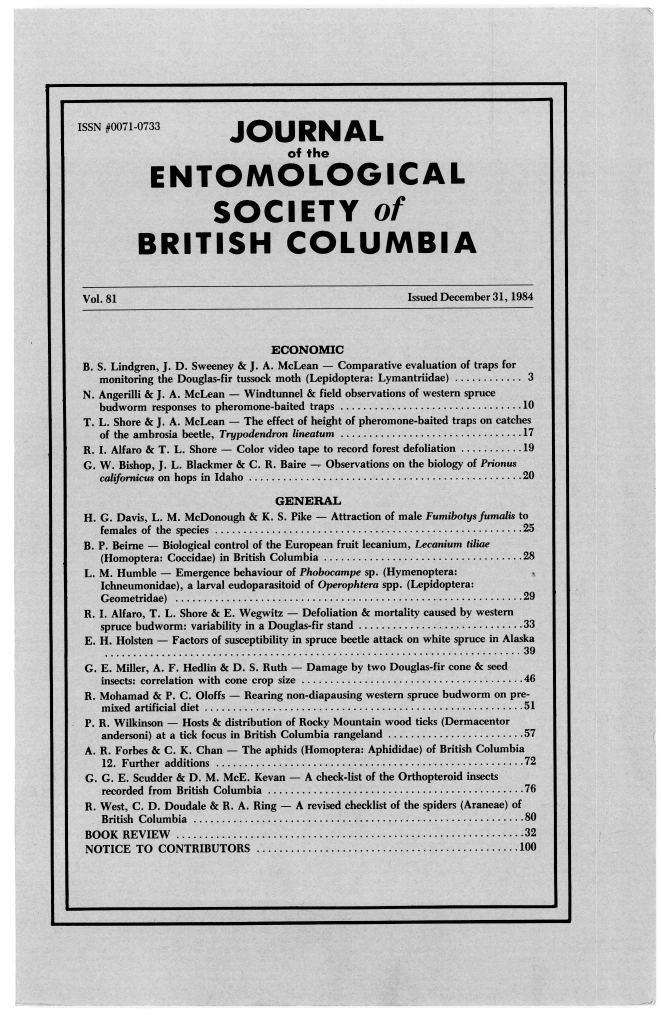Damage by two Douglas-fir cone & seed insects: Correlation with cone crop size
Keywords:
Douglas-fir cone moth, <i>Barbara colfaxiana</i>, Douglas-fir cone gall midge, <i>Contarinia oregonensis</i>Abstract
Damage by the Douglas-fir cone moth, <i>Barbara colfaxiana</i> (Kearfott), in year N was significantly related to the size of the cone crop the preceding vear (N-1) in the interior of British Columbia but not at the coast. Damage by the Douglas-fir cone gall midge, <i>Contarinia oregonensis</i> Foote, at the coast was also significantly related to cone crop size the preceding year. Fluctuations in cone crop size appear to limit populations of these cone insects.References
Annila, E. 1981. Kausen kapy-ja siementuholaisten kannanvaihtelu. Commun. Inst. For. Fenn. 101. 32 pp.
Annila, E. 1982. Diapause and population fluctuations in Megastigmus specularis Wallev and Megastigmus spermotrophus Wachtl (Hymenoptera, Torymidae). Ann. Ent. Fenn. 48:33-36.
Dobbs, R.C., D.G.W. Edwards, J. Konishi/ and D. Wallinger. 1976. Guideline to collecting cones of B.C. conifers. B.C. For. Serv./Can. For. Serv. Victoria, B.C. Joint Rep. No. 3. 98 pp.
Forcella, F. 1978. Irregularity of pinyon cone production and its relation to pinvon cone moth predation. Madrono 25:170-172.
Forcella, F. 1980. Cone predation of pinyon cone beetle (Conopthorus edulis) production. Am. Nat. 116:594-598.
Hedlin, A.F. 1960. On the life history of the Douglas-fir cone moth, Barbara colfaxiana (Kft.) (Lepidoptera: Olethreutidae), and one of its parasites, Glypta evetriae Cush. (Hymenoptera: Ichneumonidae). Can. Ent. 92:826-834.
Hedlin, A.F. 1961. The life history and habits of a midge, Contarinia oregonensis Foote (Diptera: Cecidomyiidae) in Douglas-fir cones. Can. Ent. 93:952-967.
Hedlin, A.F. 1964. Results of a six-year plot study on Douglas-fir cone insect population fluctuations. For. Sci. 10:124-128.
Hedlin, A.F., H.O. Yates III, D. Cibrian, B.H. Ebel, T.W. Koerber, and E.P. Merkel. 1980. Cone and seed insects of North American conifers. Can. For. Serv., Victoria, BC./U.S.D.A. For Serv./Secret. Agric. Recur. Hidraul., Mexico. 122 pp.
Hedlin, A.F., G.E. Miller, and D.S. Ruth. 1982. Induction of prolonged diapause in Barbara colfaxiana (Lepidoptera: Olethreutidae): correlations with cone crops and weather. Can. Ent. 114:465-471.
Hussey, N.W. 1956. The extend of seed-loss in Douglas-fir caused by Megastigmus. Scot. For. 10:191-197.
Jansen, D.H. 1971. Seed predation by animals. Ann. Rev. Ecol. Systemat. 2:465-492.
Johnson, N.E. and H.J. Heikkenen. 1958. Damage to seed of Douglas-fir by the Douglas-fir cone midge. For. Sci. 4:274-282.
Lester, D.T. 1967. Variation in cone production of red pine in relation to weather. Can. J. Bot. 45:1683-1691.
Mattson, W.J., Jr. 1971. Relationship between cone crop size and cone damage by insects in red pine seed production-areas. Can. Ent. 103:617-621.
Mattson, W.J., Jr. 1980. Cone resources and the ecology of the red pine cone beetle. Conopthorus resinosae (Coleoptera: Scolytidae). Ann. Ent. Soc. Am. 73:390-396.
Sahota, T.S., D.S. Ruth, A. Ibaraki, S.H. Farris, and F.G. Peet. 1982. Diapause in the pharate adult stage of insect development. Can. Ent. 114:1179-1183.
Sokal, R.R. and F.J. Rohlf. 1969. Biometry. W.H. Freeman & Co., San Francisco. 776 pp.
Winjum, J.K. and N.E. Johnson. 1960. A modified-knife cone cutter for Douglas-fir seed studies. J. For. 58:487-488.
Downloads
Published
Issue
Section
License
Authors who publish with the Journal of the Entomological Society of British Columbia agree to the following terms:
-Authors retain copyright and grant the journal right of first publication with the work simultaneously licensed under a Creative Commons Attribution License that allows others to share the work with an acknowledgement of the work's authorship and initial publication in this journal.
-Authors are able to enter into separate, additional contractual arrangements for the non-exclusive distribution of the journal's published version of the work (e.g., post it to an institutional repository or publish it in a book), with an acknowledgement of its initial publication in this journal.
-Authors are permitted and encouraged to post their work online (e.g., in institutional repositories or on their website) prior to and during the submission process, as it can lead to productive exchanges, as well as earlier and greater citation of published work (See The Effect of Open Access).


